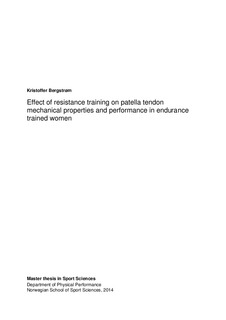Effect of resistance training on patella tendon mechanical properties and performance in endurance trained women
Master thesis
Permanent lenke
http://hdl.handle.net/11250/219177Utgivelsesdato
2014Metadata
Vis full innførselSamlinger
Sammendrag
Purpose: The purpose of this study was to investigate the effects of 12 weeks of concomitant resistance training and endurance on patella tendon (PT) mechanical properties in endurance trained women. We also wanted to investigate if any potential findings would affect running performance and economy. Methods: 17 female endurance recreational athletes were randomly assigned into two groups. Resistance + endurance training group (RT+END)(n=9) and endurance group (END)(n=8). The RT+END group performed 2 sessions of resistance training per week in addition to their regular endurance training regimen. The END group maintained their regular endurance training regimen. vastus lateralis muscle thickness and patella tendon force, elongation length and cross-sectional area (CSA) was assessed by the use of ultrasound. Isometric knee extension peak torque and squat 1 RM as well as VO2max and distance covered in 40 and 5 minutes of running was tested. The above variables were used to calculate PT stiffness, strain, Young’s modulus and running economy. All the subjects were tested at baseline and <7 days after the end of the intervention. Results: The present study revealed an increase in PT CSA (+4,8 ± 2,3% p=<0,01) and squat 1 RM (45% ± 23% p=<0,01) as a result of 12 weeks of concomitant resistance and endurance training. No changes in Isometric knee extension peak torque, vastus lateralis muscle thickness, PT mechanical properties, running performance or economy was found. Conclusion: In conclusion, PT stiffness did not change as a result of concomitant resistance and endurance training in endurance trained women. Furthermore, resistance training does not seem to be sufficient stimuli to improve running performance and economy via adaptations in PT mechanical properties.
Beskrivelse
Masteroppgave - Norges idrettshøgskole, 2014
